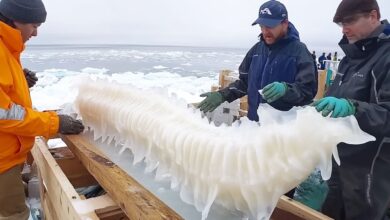150-Million-Year-Old Giant Sea Monster Found In Dorset Cliff

The Etches Collection in Dorset is now home to an extraordinary discovery: the skull of a giant pliosaur, a marine reptile that lived around 150 million years ago. Unlike dinosaurs, pliosaurs were marine predators, and this particular specimen is believed to be a new species. Scientists suggest that this ancient sea monster, estimated to be 12 meters long, could have been powerful enough to defeat a T-Rex in combat.
The discovery began with a fossilized snout found on a Dorset beach. Fossil hunters Steve Etches and Chris Moore, featured in a BBC series by David Attenborough, were tasked with recovering the skull from a cliff face, an operation that was far from easy. They initially used drones to scan the cliff and confirm the rest of the skull’s location, buried deep in the mudstone cliff.
The skull, found upside down with its lower jaw facing up, required two weeks of continuous chiseling to extract. The team initially considered using a landing craft to transport it, but the plan was deemed too costly and complex. Instead, they developed a special cage and used heavy machinery to pull the skull up the cliff.
Once the skull reached the workshop, it underwent further preparation. The team noticed unique features, such as a crest that had never been seen in other pliosaurs and a jawline extending far past the eye. These differences strongly indicate that it could be a new species.

The fossil also included teeth, some of which had fallen out and were carefully reassembled over 14 hours. Unlike previous pliosaur models, which showed only the tooth crowns, this specimen had roots that extended well beyond the jawline, offering new insights into its anatomy.
Pliosaurs were apex predators, using their massive jaws and teeth to capture prey like ichthyosaurs. The fossil-rich Jurassic Coast, where the pliosaur was found, has been eroded by the English Channel for centuries, continually revealing new fossils. The discovery of this giant pliosaur adds to the diverse range of marine life already found along the coast, including ichthyosaurs, plesiosaurs, ammonites, and flying reptiles.
Though the skull is now on display, the rest of the pliosaur’s body remains embedded in the cliff, waiting to be uncovered. The team has already found parts of the shoulder blade, paddles, and vertebrae, indicating that more of the skeleton is likely intact. Visitors to the Etches Collection and the surrounding Jurassic Coast can explore a rich array of fossils, from ammonites to marine reptiles, offering a glimpse into the prehistoric world. The full story of the pliosaur’s discovery is featured in the BBC documentary *Attenborough and The Giant Sea Monster*.








